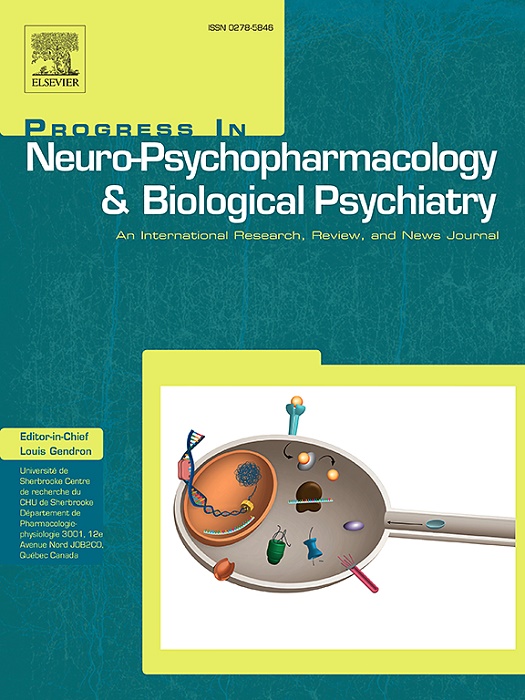EEG microstates, acute phase negative symptoms of schizophrenia and antipsychotic treatment response
IF 3.9
2区 医学
Q1 CLINICAL NEUROLOGY
Progress in Neuro-Psychopharmacology & Biological Psychiatry
Pub Date : 2025-08-06
DOI:10.1016/j.pnpbp.2025.111466
引用次数: 0
Abstract
EEG microstates are transient scalp topographies reflecting whole-brain electric potential that remain quasi-stable for 60–120 ms. Microstates exhibitalterations across all phases of schizophrenia; especially an increased microstate C and a decreased microstate D were linked to aberrant salience.
We aimed to investigate the relationship of microstates with illness severity in the positive, negative, disorganized, excited and depressed symptoms domains, and with response to antipsychotics.
Forty-five inpatients were clinically evaluated at admission and 40 patients were also assessed after 6 weeks, to determine response to treatment; patients and 31 healthy controls underwent a 5-min resting-state EEG with 128-electrodes, to assess microstates A-E.
The severity of negative symptoms was negatively associated with microstate C time coverage (trend = − 0.5249; P = 0.0078) and duration (trend = −0.737; P = 0.0001).
In responders vs non-responders to treatment, microstate C had increased time coverage (p = 0.0052; d = −0.979), duration (P = 0.0168; d = −0.836) and global explained variance (GEV; P = 0.0046; d = −0.995), microstate D occurrence was reduced (P = 0.0044; d = −1.010), microstate E time coverage (p = 0.0148; d = 0.853), occurrence (P = 0.0037; d = 1.030) and GEV were reduced (P = 0.0115; d = 0.885). All the above reported findings remained significant when controlling for multiple comparisons.In conclusion, findings corroborate the hypothesis that the microstate C![]() D imbalance is a key pathophysiology mechanism of schizophrenia, herein not only related to negative symptoms, but also predicting the response to antipsychotics, together with microstate E dynamics.
D imbalance is a key pathophysiology mechanism of schizophrenia, herein not only related to negative symptoms, but also predicting the response to antipsychotics, together with microstate E dynamics.
脑电图微观状态、精神分裂症急性期阴性症状与抗精神病药物治疗反应
脑电微状态是反映全脑电位的瞬态头皮地形,在60-120 ms内保持准稳定。微观状态在精神分裂症的所有阶段都表现出改变;特别是微态C的增加和微态D的减少与异常显著性有关。我们的目的是调查在阳性、阴性、紊乱、兴奋和抑郁症状领域的微观状态与疾病严重程度的关系,以及与抗精神病药物的反应的关系。入院时对45例住院患者进行临床评估,6 周后对40例患者进行评估,以确定对治疗的反应;采用128个电极对患者和31名健康对照者进行5分钟静息状态脑电图,评估a -e微观状态。阴性症状的严重程度与微状态C时间覆盖率呈负相关(趋势 = - 0.5249;P = 0.0078)和持续时间(趋势 = -0.737; = 0.0001页)。在对治疗有反应者和无反应者中,微状态C的时间覆盖率增加(p = 0.0052;d = -0.979),持续时间(P = 0.0168;d = -0.836)和全局解释方差(GEV;P = 0.0046;d = -0.995),微态d发生率降低(P = 0.0044;d = -1.010),微态E时间覆盖率(p = 0.0148;d = 0.853),发生率(P = 0.0037;d = 1.030),GEV降低(P = 0.0115;d = 0.885)。在控制多重比较时,上述所有报告的结果仍然显著。综上所述,研究结果证实了微状态CD失衡是精神分裂症的关键病理生理机制的假设,不仅与阴性症状有关,而且与微状态E动力学一起预测抗精神病药物的反应。
本文章由计算机程序翻译,如有差异,请以英文原文为准。
求助全文
约1分钟内获得全文
求助全文
来源期刊
CiteScore
12.00
自引率
1.80%
发文量
153
审稿时长
56 days
期刊介绍:
Progress in Neuro-Psychopharmacology & Biological Psychiatry is an international and multidisciplinary journal which aims to ensure the rapid publication of authoritative reviews and research papers dealing with experimental and clinical aspects of neuro-psychopharmacology and biological psychiatry. Issues of the journal are regularly devoted wholly in or in part to a topical subject.
Progress in Neuro-Psychopharmacology & Biological Psychiatry does not publish work on the actions of biological extracts unless the pharmacological active molecular substrate and/or specific receptor binding properties of the extract compounds are elucidated.

 求助内容:
求助内容: 应助结果提醒方式:
应助结果提醒方式:


